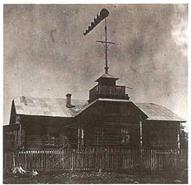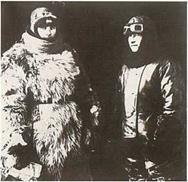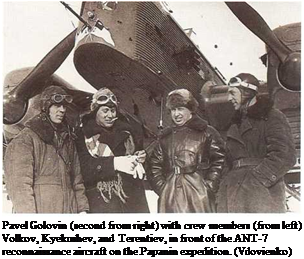To The End of the Line
|
Island Outposts While the Soviet Union was, geographically, one vast land area, there were a few offshore islands. Those in the Arctic Ocean were of little commercial importance, although they had some strategic value; but those in the far east were very important strategically, and contained some natural resources. If only because of a latent suspicion of Japanese ambitions in the area, Moscow had to ensure close ties to the extremes of its empire. The island of Sakhalin, though only a few kilometers from the Asian land mass at one point, was difficult to reach; while the peninsula of Kamchatka, separated from the rest of Russia by the Sea of Okhotsk, might as well have been a distant island. A plan to build a railway from Khabarovsk to Nikolayevsk – na-Amure was postponed because of the difficulties of building a line through the Amur swamplands. Instead, Dobrolet was given the task of building an air route. Pioneer Route During 1929, Comrade Nijnakovsky blazed a trail by dog-sled from Khabarovsk to Nikolayevsk. He laid down supplies of fuel, food, shelter, and medical supplies (and not forgetting waterproofed packets of matches), ready for any emergency en route. Then, on an historic day, 9 January 1930, Mikhail Vodopyanov left Khabarovsk in a Junkers Ju 13 floatplane (illustrated on page 15), and flew to Aleksandrovsk- Sakhalinskiy, the chief city of Sakhalin, which in those days |

|
AEROFLOT’S FAR EAST |

|
REGD |

|
)Lazo |

|
•kutsk |



MARTIN 156 50 SEATS ■ 225km/h (140mph)

 Wright Cyclone GR-1820-G2 (4 x 850hp) ■ MTOW 28,100kg (62,0001b) ■ Normal Range 2,000km (l,200mi) ■ Length 28m (92ft) ■ Span 48m (157ft)
Wright Cyclone GR-1820-G2 (4 x 850hp) ■ MTOW 28,100kg (62,0001b) ■ Normal Range 2,000km (l,200mi) ■ Length 28m (92ft) ■ Span 48m (157ft)


The Savoia-Marchetti S.55P
Local services began to develop In the Far East area. A circular route was established to some small communities to the north and east of Blagoveschensk, with Polikarpov Po-2 and Shavrov Sh-2 amphibians, and the Junkers Ju 13s were replaced with larger aircraft. Aeroflot negotiated for five Savoia-Marchetti S.55P twin-boom flying boats, the same type that had been used by Marshal Balbo in the famous trans-Atlantic squadron flight from Italy to Brazil in 1930. The S.55P inaugurated Aeroflot service to Petropavlovsk in 1933, by the circuitous route around the Sea of Okhotsk (see map opposite), the aircraft having been delivered from Italy by a circuitous route via the Black Sea, the great Russian rivers, as well as Lake Baikal.
The Russian Clipper
Flying to Sakhalin, and especially to Kamchatka, was an adventure, and the journey by S.55P to Petropavlovsk usually took about five or six days in the summer. Accordingly, Aeroflot upgraded to larger equipment, the Martin 156, the so-called ‘Russian Clipper’, an improved version of the famous China Clipper Martin 130 delivered to Pan American Airways in 1935.
The Far East Region of Aeroflot needed an aircraft that could combine a good payload with a good range, enough to traverse the southern part of the Sea of Okhotsk, preferably nonstop from Khabarovsk to Petropavlovsk. The Glenn Martin (as it was always referred to in Russia) could normally carry 50 passengers, and on shorter trips, for example, Khabarovsk to Nikolayevsk-na-Amure, it could carry 70. The Martin 156 — designated SP-30 by Aeroflot — was delivered in 1940 and operated successfully during the summer months until 1944, when it had to be retired because of the difficulty in obtaining spare parts.
The Clipper was replaced by the Consolidated Catalina in 1943 or 1944. Three Consolidated Model 28-ls had been imported from the U. S. in 1938 and, from 1940, license production of the type was undertaken at Taganrov, on the Sea of Azov, as the GST (Gidro Samolyet Transportnyi, or hydro aircraft transport) for the Soviet Navy. A few civil examples, designated MP-7, were delivered to Aeroflot. Some Lisunov Li-2s are believed to have been used also.
















